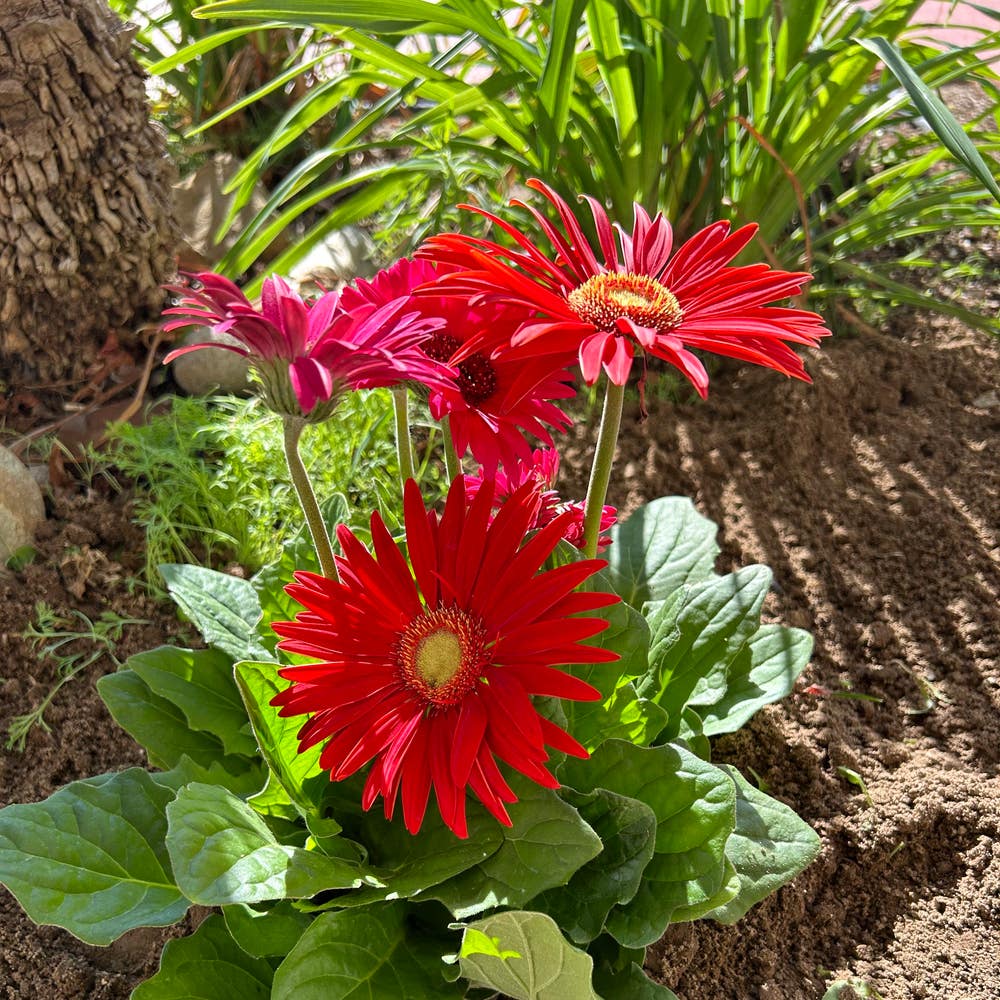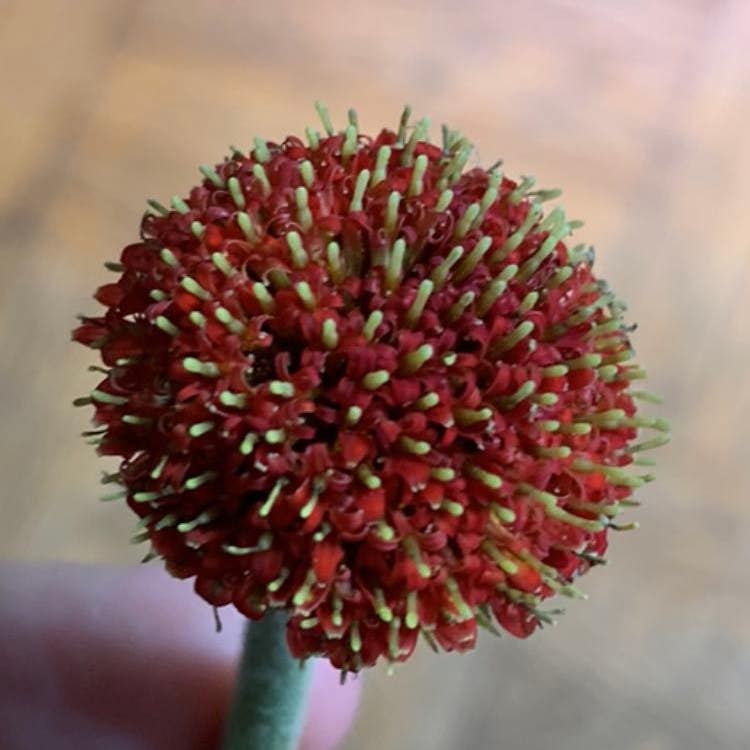Am I Starving My Gerbera? Fertilizing 101
Dec 16, 2023•7 min read
Boost your Gerbera's bloom 🌼 with the perfect fertilization plan—lush flowers guaranteed!
- N-P-K ratio crucial for Gerbera's vibrant blooms and robust growth.
- Adjust fertilization with growth phase; over-fertilization signs include leaf scorch, wilting.
- Organic options available, like vermi-compost, for eco-friendly nutrient supply.
Essential Nutrients for Gerbera Blooming
Gerbera daisies are not just pretty faces; they're hungry for specific nutrients to flaunt those vibrant blooms.
🌱 The Big Three: N-P-K
Nitrogen (N) is the go-to for lush, green leaves, but overdo it and you'll get all leaf, no flower. It's the building block for plant proteins, essential for cell growth and photosynthesis.
Phosphorus (P) is the backstage hero for Gerbera blooming. It's all about the roots, buds, and blooms, helping to transfer energy where it's needed most. Without it, your Gerbera's performance is lackluster.
Potassium (K) is the plant's personal trainer, regulating stomata function and strengthening against drought. It's the key to robust flower formation and overall plant stamina.
⚖️ Balancing Act
The N-P-K ratio is your cheat sheet for feeding Gerberas. Too much nitrogen and you'll sabotage the blooms. Aim for a balanced meal—think medium levels of fertilization with 150 to 200 ppm N.
🌡️ pH: The Gatekeeper
The optimal substrate pH for Gerberas is between 5.8 and 6.2. Stray from this sweet spot, and you're looking at nutrient uptake issues, with iron (Fe) and manganese (Mn) being the usual suspects.
🌿 Organic Alternatives
In the spirit of keeping things eco-friendly, consider bio-stimulants. They're like probiotics for your plants, enhancing nutrient uptake without the environmental guilt trip.
Real Talk
Remember, Gerberas are not high-maintenance divas; they just need their nutritional needs met. Get the balance right, and you'll be rewarded with a garden of ceaseless color.
Choosing the Right Fertilizer for Gerbera
Gerbera daisies are not just pretty faces; they're hungry plants that crave the right nutrients. Choosing the right fertilizer is like picking the perfect dish at a buffet for your gerberas – it's got to have all the good stuff.
🥤 Liquid, Granular, or Slow-Release?
Liquid fertilizers are the quick snack of the plant world, offering a rapid nutrient boost. They're great for a fast pick-me-up but need reapplication every couple of weeks. Granular fertilizers, on the other hand, are the slow-cooked meals that keep on giving, releasing nutrients over time. They're applied less frequently, making them a low-maintenance option. Then there's the slow-release type, the crockpot of fertilizers, which steadily supplies your gerberas with nutrients, minimizing the risk of overfeeding.
🎩 The Magic N-P-K Ratio
The N-P-K ratio on fertilizers is like a secret code for plant growth. For gerberas, aim for a balanced N-P-K ratio, like 10-6-4, to support robust growth and vibrant blooms. Too much nitrogen, and you'll get a leafy green plant with few flowers. Not enough potassium, and your gerberas might as well wave a white flag.
🌾 Micronutrients Matter
Don't forget the micronutrients. Iron and manganese are the unsung heroes for gerberas, especially when potted. A fertilizer that includes these can prevent those pesky deficiencies that leave plants looking lackluster.
🌿 Organic Options
If you're leaning green, vermi-compost is your friend. It's like a superfood smoothie for your gerberas, packed with all the nutrients they crave. Plus, it's environmentally friendly, which means you can feed your flowers without the guilt.
📦 Real Talk on Fertilizer Types
Let's be real, the fertilizer aisle can be overwhelming. But here's the scoop: if you want low-maintenance, go granular. If you're all about that immediate gratification, liquid's your game. And if you're the set-it-and-forget-it type, slow-release will be your jam.
Remember, your gerberas aren't picky eaters – they just want a well-rounded meal. So pick a fertilizer that suits your style and watch those blooms pop.
Timing and Frequency of Fertilization
Gerbera daisies are not one-size-fits-all when it comes to feeding.
🌼 Pre-Blooming Phase
Spring is a wake-up call for your Gerbera. It's time to start a monthly fertilization routine. Use a balanced liquid fertilizer, but remember, it's like a light breakfast—half-strength is plenty.
🌸 Blooming Phase
Come the blooming season, your Gerbera's appetite changes. Stick to the monthly ritual, but now you can go full strength with that fertilizer. It's like switching from a jog to a sprint; your plant needs that extra energy.
🌺 Post-Blooming Care
After the show's over, reduce fertilization to a quarter-strength. It's the plant equivalent of a relaxing yoga session, helping your Gerbera wind down.
Year-Round Tips
- Consistency is key. Mark your calendar; Gerberas thrive on routine.
- Observe your plant. Yellow leaves? Dial back on the nitrogen. Slow growth? It might be craving more phosphorus.
- Watering days without fertilizer? Yes, please. It prevents salt build-up that could turn your Gerbera's life sour.
- Automated systems are great, but they lack the personal touch. Don't let machines dictate your Gerbera's diet.
Remember, you're not just a gardener; you're a chef for your plants. Serve up the right dish at the right time, and your Gerbera will reward you with a floral feast for the eyes.
Fertilization Techniques for Optimal Blooming
🌸 Step-by-Step Fertilization Guide
- Dilution is key. Mix liquid fertilizer to half-strength, ensuring you don't overwhelm your Gerbera.
- Apply this concoction once a month during the blooming phase, when your plant's energy needs skyrocket.
- For potted Gerberas, consider a gentle pour around the base, avoiding direct contact with leaves and stem.
- Garden Gerberas thrive with a granular, slow-release option, lightly worked into the soil around the plant.
🌱 Potted vs. Garden Gerberas
- Potted plants: They're confined, so they rely on you for everything. Consistency in feeding them is your mantra.
- Garden plants: They have more freedom but still need your watchful eye. A time-release fertilizer can be your best ally here, providing nutrients steadily.
🔍 Pro Tips
- Observe your Gerbera's response. Yellowing leaves? Ease up on the nitrogen. Lackluster blooms? Amp up the phosphorus.
- Avoid root burn by never going overboard. If you do, flush the soil with water to dilute the excess fertilizer.
Remember, fertilizing is more art than science—tweak your technique as you learn your plant's language.
Recognizing and Correcting Over-Fertilization
Gerbera plants, like any other, can suffer from too much of a good thing when it comes to fertilization. Recognizing the signs of over-fertilization is crucial to keep your Gerberas thriving.
🚨 Signs of Excess Fertilizer
- Leaf scorch: Brown tips or edges on leaves may indicate fertilizer burn.
- Stunted growth: A plant that stops growing or grows very slowly might be struggling with nutrient overload.
- Wilting: Despite adequate watering, wilting can occur if the roots are damaged by excessive fertilizer.
- Leaf drop: Older leaves falling off prematurely could be a distress signal from your Gerbera.
- Lack of blossoms: If your Gerbera isn't blooming, it might be due to an imbalance caused by too much fertilizer.
🛠️ Correcting the Issue
- Stop fertilizing: Give your plant a break to recover from the nutrient excess.
- Leach the soil: Flush the soil with water to wash away excess salts. This can be done by running water through the pot for a few minutes.
- Remove damaged foliage: Trim away any brown or damaged leaves to help the plant focus on new growth.
- Monitor and adjust pH: Check the soil's pH, as nutrient imbalances can cause pH shifts. Adjust with lime or sulfur as needed.
- Repotting: In severe cases, repotting your Gerbera in fresh soil can give it a new lease on life.
🚫 Preventing Future Over-Fertilization
- Dilute your fertilizer: Always follow the recommended dilution rates.
- Even application: Spread fertilizer evenly around the plant to avoid concentrated spots that can harm the roots.
- Regular checks: Keep an eye on your plant's response after fertilization to catch any issues early.
- Fertilize during growth: Only fertilize when your Gerbera is actively growing, typically in spring and summer.
By staying vigilant and responsive to your Gerbera's needs, you can avoid the pitfalls of over-fertilization and enjoy a garden full of vibrant blooms.


